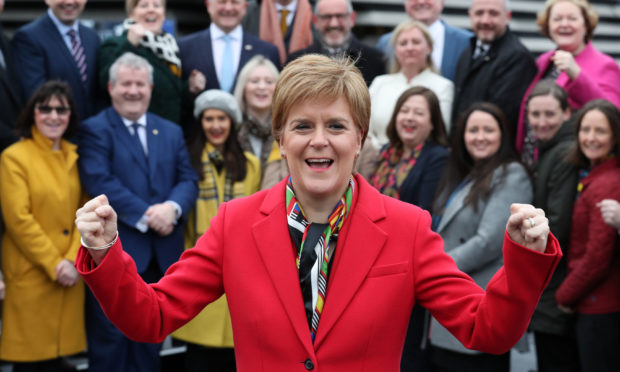This week will hopefully bring welcome respite from the political cacophony of the past few months. But any expectation that the election result will curtail campaigning is misplaced; in Scotland, the real battle lines have just been drawn.
First minister Nicola Sturgeon may have downplayed her independence agenda in the run-up to December 12, but by the 13th she was back on her soap box.
This, of course, is entirely predictable. But what is giving cause for concern, among those of us who don’t want to see Britain torn apart, is the latest strategy being trialled by the Scottish Nationalists.
This involves senior SNP figures declaring something to be true because they wish it were so, regardless of the actual truth.
It’s not necessarily a new weapon in the propaganda war, either at home or globally – after all, it propelled Donald Trump to victory in the US three years ago.
The SNP is currently using the ploy to give the impression, particularly to people outside Scotland, that it alone represents the Scottish population.
For example, in Westminster on Friday, Ian Blackford, re-elected MP for Ross, Skye and Lochaber, and again leading the SNP’s contingent in the Commons, declared that “Scotland still totally and utterly rejects Brexit”.
Those were his words, as reported by Hansard, stating that voters north of the border were unequivocally in favour of remaining in the EU.
While a decisive majority, 62%, were indeed pro-Remain – and it is argued, plausibly, that this majority helped secure the SNP’s anti-Brexit advances in the general election – many Scots voted to leave the EU.
This group included some 400,000 Scottish Nationalists who, logically, do not see the point of seizing control from London only to then give it back again to Brussels.
However, these inconvenient colleagues went unacknowledged by Mr Blackford, who simply erased them from the record.
The tactic – a rather polite term for what is in fact a lie – is a more sophisticated version of fake news: a fake consensus.
By repeating loudly that Scotland now has a mandate for a second independence referendum because the SNP won more seats than any other Scottish party, the Nationalists hope to build an unstoppable momentum.
They need to do something drastic because the prime minister, Boris Johnson, has refused to approve a Section 30 order, the legal requirement Scotland needs to stage a repeat of the 2014 plebiscite.
If it were widely known that most Scots did not want further constitutional upheaval, and that poll after poll has shown a majority against a new ballot on independence, there would be little sympathy outwith the secessionist movement for indyref2.
But if the Nationalists were to prove a consensus existed in Scotland to rerun the 2014 ballot, pressure would mount on Johnson and his Conservative government in London.
Sturgeon knows she does not have this consensus but that is not holding her back. She just has to invent a fake consensus.
Here she was last week, as she was about to launch her paper, Scotland’s Right to Choose: Putting Scotland’s Future in Scotland’s Hands, saying: “Whatever people’s views on the issue of independence itself, there is a wide and growing consensus that Scotland must be able to choose its own future.
“Now that the election is over, and the result so overwhelmingly clear, I believe that consensus is growing by the day.”
The result was very clear, in that 55% of Scots voted for Unionist parties, and the consensus is only growing inside the head of Sturgeon.
But unsubtle as it is, the Nationalist message appears – like much fake news – to be gaining traction in the more gullible sections of the media.
On the Today show last week, a BBC reporter was sent to Inverclyde to collect evidence of a shift in attitudes to independence – a narrative that could have been scripted by Sturgeon herself.
The vote in the constituency in 2014 was very narrowly (50.1 to 49.9 %) in favour of the Union, but the BBC man managed to talk to a couple of locals who had changed their minds.
On this basis alone, he was able to detect a symptomatic swing towards nationalism in Scotland’s shipbuilding heartlands.
Scottish politics are scrutinised intermittently beyond these borders and Sturgeon, along with some of her ministers, is often let off the hook in her pop-up appearances in London.
But with Westminster proving perhaps the best bulwark between Nationalist clamour and Unionist anxiety, it has never been more important for the more silent majority to be heard.
If anyone out there really is listening, there is no consensus for renewed fighting over the constitution – Scots do not want a second independence referendum.
This country voted in the general election on December 12 along the same lines as five years ago: Scotland’s future is already in Scotland’s hands.
